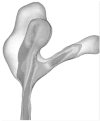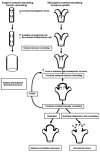Intracranial aneurysms: links among inflammation, hemodynamics and vascular remodeling
- PMID: 16759441
- PMCID: PMC2754184
- DOI: 10.1179/016164106X14973
Intracranial aneurysms: links among inflammation, hemodynamics and vascular remodeling
Abstract
Abnormal vascular remodeling mediated by inflammatory cells has been identified as a key pathologic component of various vascular diseases, including abdominal aortic aneurysms, brain arteriovenous malformations and atherosclerosis. Based on findings from observational studies that analysed human intracranial aneurysms and experimental studies that utilized animal models, an emerging concept suggests that a key component of the pathophysiology of intracranial aneurysms is sustained abnormal vascular remodeling coupled with inflammation. This concept may provide a new treatment strategy to utilize agents to inhibit inflammation or cytokines produced by inflammatory cells such as matrix metalloproteinases. Such an approach would aim to stabilize these vascular lesions and prevent future expansion or rupture.
Figures




References
-
- Schievink WI. Intracranial aneurysms. N Engl J Med. 1997;336:28–40. - PubMed
-
- Juvela S. Treatment options of unruptured intracranial aneurysms. Stroke. 2004;35:372–374. - PubMed
-
- Hashimoto T, Wen G, Lawton MT, et al. Abnormal expression of matrix metalloproteinases and tissue inhibitors of metalloproteinases in brain arteriovenous malformations. Stroke. 2003;34:925–931. - PubMed
-
- Knox JB, Sukhova GK, Whittemore AD, et al. Evidence for altered balance between matrix metalloproteinases and their inhibitors in human aortic diseases. Circulation. 1997;95:205–212. - PubMed
-
- Goodall S, Crowther M, Hemingway DM, et al. Ubiquitous elevation of matrix metalloproteinase-2 expression in the vasculature of patients with abdominal aneurysms. Circulation. 2001;104:304–309. - PubMed
Publication types
MeSH terms
Grants and funding
LinkOut - more resources
Full Text Sources
Other Literature Sources
Medical
